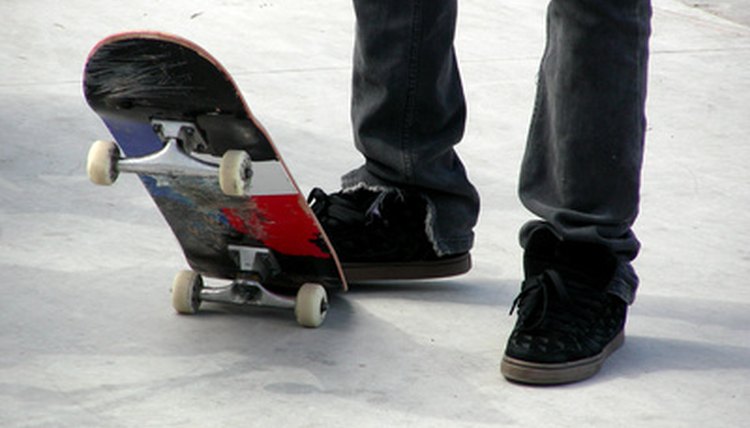How to Make Polyurethane Skateboard Wheels

Skateboard wheels are typically mass-produced in an industrial setting. They are made of polyurethane, a versatile and durable synthetic material. According to 1skates.com, Frank Nasworthy invented polyurethane skateboard wheels in 1970. With their rubber-like grip on the pavement, polyurethane wheels expanded the potential of ways that skateboards could be used. Different types of polyurethane skateboard wheels vary mainly in terms of their durometer, diameter, color, and shape. The durometer is a measure of how hard the wheel is. Soft wheels, best for cruising on hard surfaces, have low durometers, such as 87A. Hard wheels, which absorb little shock, have a higher durometer, like 100A. The diameter is the height of the wheel. Making polyurethane skateboard wheels involves the use of specialized chemicals and machinery. This process is indicative of the basic industrial processes by which polyurethane wheels are made.
Polyurethane Wheels
Mix a batch of polyurethane. Combine the chemical components of the polyurethane in the appropriate proportions in a metering machine. A metering machine is a machine that heats, mixes and dispenses polyurethane.
Add color. When the polyurethane in the metering machine is a liquid, add dye or some other type of pigment to the batch. This is only necessary if you want your skateboard wheels to have a color.
Pour polyurethane into molds. The molds should be made of aluminum and reflect the shape and size you want your wheels to be.
Remove the polyurethane “slugs” from the mold after the polyurethane has solidified. Slugs are the basic, unfinished form of your polyurethane skateboard wheels. Place the slugs on a flat surface to fully cure.
Shape the wheel. Use a lathe to cut the slug into shape. The sides and riding surface of the wheels should be cut to match each other exactly. A lathe is a piece of machinery that turns an object as it shapes it. In this case the lathe turns the slug as it cuts away excess polyurethane.
Tips
Heat is not necessarily required to mix polyurethane, though it may produce a higher quality wheel.
Warnings
According to Exploratorium.edu, clear, uncolored wheels may be the strongest. Adding pigments or dye, which displace the polyurethane, may weaken the wheel.
References
Tips
- Heat is not necessarily required to mix polyurethane, though it may produce a higher quality wheel.
Warnings
- According to Exploratorium.edu, clear, uncolored wheels may be the strongest. Adding pigments or dye, which displace the polyurethane, may weaken the wheel.
Writer Bio
Keith Vaughn is an artist and writer in Asheville, NC. Vaughn regularly writes essays and fine art reviews for Bees And Trees Blog. He also paints and exhibits his work regularly. He holds a Master of Fine Arts from the Cranbrook Academy of Art.
